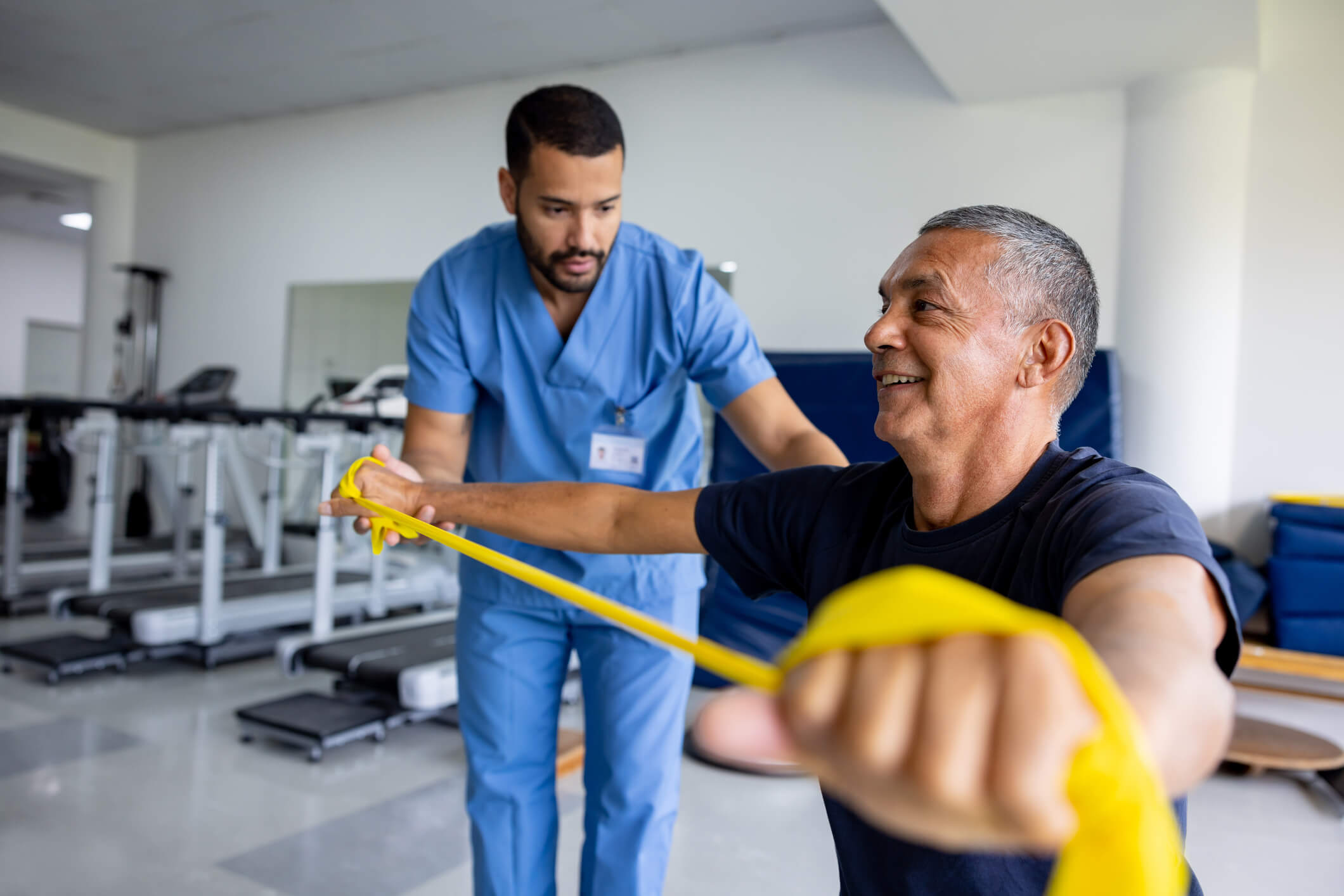The job outlook for physical therapist assistants (PTAs) is good—no—make that great. According to data from the U.S. Bureau of Labor Statistics, the demand for PTAs is projected to increase 19% by the year 2032. That’s much faster than the national average.
If you are entering the job market for the first time, or you’re a seasoned PTA looking for a new opportunity, we are here to help. We’ve compiled five common interview questions along with tips for answering them, so you can make a great impression during your job search.
What Is a Physical Therapy Assistant?
Physical therapist assistants work closely with physical therapists to help rehabilitate patients with a wide range of musculoskeletal injuries, illnesses, or disabilities that impact movement.
Under the guidance of licensed physical therapists, PTAs help patients perform prescribed exercises and stretches to move and feel better. They also provide manual therapies to reduce pain and improve mobility and range of motion in patients of all ages.
PTAs show patients how to use rehabilitative equipment and educate them on at-home exercise programs and self-care interventions to support their efforts in the clinic. They observe patients and take detailed notes to monitor their progress, and consult with their supervising physical therapist to make adjustments as needed.
In most states, PTAs must complete an accredited physical therapy assistant education program and pass a state-administered national exam to become licensed. PTA education programs generally run two years or five semesters. Many states also require continuing education for PTAs and physical therapists on an annual or biennial basis.
Although nearly three-quarters of PTAs work in hospitals and private clinics, they can also find employment in schools, home health, and rehabilitation facilities.
Interview Tips for Physical Therapy Assistants: How to Respond To Common Questions
Now, let’s review some questions you might encounter during an interview for a PTA position.
1. Why Did You Become a PTA?
Many PTAs have a desire to help people feel better and improve their quality of life. They are also curious about how the human body works and ways to improve performance and overcome injuries. Maybe you are inspired to work with a specific population like youth athletes or seniors. When you answer this question, think back to when you first developed an interest in physical therapy. Feel free to share that. Or you can talk about something more recent, like a patient’s positive outcome, that confirmed you made the right career choice.
Keep in mind, there is no “right” answer. Your career values and goals are just as unique as you are. Speak from the heart to give the interviewer a glimpse into what inspires you personally and professionally.
Example: My interest in physical therapy began when I played competitive soccer during my teen years. I suffered a sports injury that required surgery and physical therapy. I was able to overcome that setback and resume playing once my injury healed. That experience created a passion for working with athletes of all ages to help them recover from sports injuries and return to play strong and healthy.
2. How Do You Manage Your Workload?
If you have spent any time in a clinic or hospital, you know just how chaotic a typical day can be. Employers want to know you won’t cave under the pressure, that you can manage a busy caseload while providing the personal care and attention every patient deserves.
Example: In the morning, I take a few moments to create a “to-do” list for the day, listing my tasks in order of priority. I check in with my supervisor to go over the day’s cases so I can plan accordingly. If an appointment runs long, or we encounter some other delay, I communicate with any team members who may be impacted so we can make adjustments as needed.
3. How Do You Track Patients’ Progress?
Maintaining patient records and monitoring their progress are part of your role as a PTA. This information is essential for creating customized treatment plans to help patients reach their therapy goals.
Candidates with experience in physical therapy records management will stand out. It’s also helpful to mention your commitment to handling sensitive patient information with the utmost discretion to ensure confidentiality and compliance with HIPPA guidelines.
Example: Throughout my PTA career, I have utilized several electronic health record (EHR) systems. I also consider myself a “quick study” when it comes to technology and generally adapt to new systems quickly. I take patient privacy very seriously and store patient files securely according to guidelines from the World Confederation of Physical Therapy (WCPT.)
4. How Do You Handle Stress?
What do you do if a patient’s appointment runs long, or it’s delayed because another provider was seeing them? What about the patient who is resistant to treatment, or doesn’t do their home exercise program? Stress can come from within the organization too. What about a difficult colleague or micromanaging supervisor?
When you talk about workplace challenges, acknowledge that stress is inevitable, especially when you work with patients who are living with health and medical challenges. It’s essential to have healthy coping mechanisms to manage stress at work and at home. Share the techniques and tricks you use to stay calm, focused, and prepared for whatever comes your way.
Example: I have a few tried and true methods to manage stress on the job. It can be as simple as taking a few deep breaths or going for a quick walk outside when time permits. I have a professional mentor I can go to for support and guidance and hope to do the same for other new PTAs as my career advances.
I know that burnout is a real concern among health and wellness professionals. That is why I do all I can to stay healthy and well by eating right, exercising, and getting enough sleep. When I am feeling good, I’m better equipped to help my patients feel their best too.
5. How Do You Motivate Patients?
Physical therapy is only successful when patients are receptive and engaged with the process. If they are not consistent about participation, results will come much more slowly—if at all. Describe your approach for encouraging patients to continue physical therapy and their home exercise program (HEP.)
Example: In my experience, setting realistic goals and highlighting “wins” are the most effective ways to keep patients motivated. Personal connections are powerful too. I build trust with patients by listening to their concerns and reminding them of the benefits of sticking with their physical therapy program.
When I encounter patients who are resistant to physical therapy, I take an empathetic approach and try to see the situation from their perspective. After all, health challenges can be frustrating. Sometimes all they need is a bit of support and encouragement to keep moving forward.
Now that we’ve covered the basics, it’s time to practice. Review these questions and develop your responses based on your own experience and training. Go over these questions with a friend or in the mirror to help you feel more prepared and at ease when it’s time for the real interview.
Physical therapy is an incredibly rewarding profession for therapists and assistants alike. Do you want to learn more about becoming a PTA or want to learn about working with Upstream Rehabilitation? Find your next career here.




